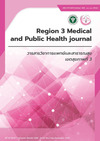การศึกษาอุบัติการณ์และปัจจัยที่สัมพันธ์กับภาวะความดันโลหิตต่ำจากการฉีดยาชาเข้าช่องน้ำไขสันหลังในผู้ป่วยที่เข้ารับการผ่าตัดในโรงพยาบาลโพธาราม
คำสำคัญ:
ความดันโลหิตต่ำ, การฉีดยาชาเข้าช่องน้ำไขสันหลัง, ปัจจัย, อุบัติการณ์บทคัดย่อ
บทคัดย่อ
วัตถุประสงค์ : เพื่อศึกษาอุบัติการณ์และปัจจัยที่สัมพันธ์กับภาวะความดันโลหิตต่ำจากการฉีดยาชาเข้าช่องน้ำไขสันหลังในผู้ป่วยที่เข้ารับการผ่าตัดในโรงพยาบาลโพธาราม
วิธีการศึกษา : เป็นการวิจัยเชิงวิเคราะห์แบบไปข้างหน้าในผู้ป่วยที่ได้รับการระงับความรู้สึกด้วยวิธีฉีดยาชาเข้าช่องน้ำไขสันหลังสำหรับการผ่าตัดในโรงพยาบาลโพธารามตั้งแต่เดือนกันยายน 2563 ถึง ธันวาคม 2564 จำนวน 234 ราย โดยทำการเก็บรวบรวมข้อมูลด้านผู้ป่วย ข้อมูลด้านการระงับความรู้สึกและข้อมูลด้านการผ่าตัด กำหนดให้ผู้ป่วยที่มีค่าความดันซิสโตลิกลดลงมากกว่าร้อยละ 20 ของค่าความดันโลหิตพื้นฐานของผู้ป่วยหรือน้อยกว่า 90 มิลลิเมตรปรอทเป็นผู้ป่วยที่มีภาวะความดันโลหิตต่ำ
ผลการศึกษา : พบอุบัติการณ์ภาวะความดันโลหิตต่ำจากการฉีดยาชาเข้าช่องน้ำไขสันหลังร้อยละ 61.1 เมื่อทำการวิเคราะห์ด้วย Univariate Analysis พบว่าเพศ น้ำหนัก ส่วนสูง ดัชนีมวลกาย ความดันซิสโตลิกพื้นฐาน ชนิดของยา Bupivacaine และระดับการชา เป็นปัจจัยที่มีความสัมพันธ์กับภาวะความดันโลหิตต่ำจากการฉีดยาชาเข้าช่องน้ำไขสันหลังอย่างมีนัยสำคัญทางสถิติ (p-value<0.05) แต่เมื่อนำปัจจัยดังกล่าวมาวิเคราะห์ด้วย Multivariate Analysis พบว่าความดันซิสโตลิกพื้นฐานและระดับการชาเป็นปัจจัยที่มีผลต่อการเกิดภาวะความดันโลหิตต่ำจากการฉีดยาชาเข้าช่องน้ำไขสันหลัง โดยความดันซิสโตลิกพื้นฐานที่เพิ่มขึ้นทุก 1 มิลลิเมตรปรอท มีโอกาสเกิดภาวะความดันโลหิตต่ำจากการฉีดยาชาเข้าช่องน้ำไขสันหลังเพิ่มขึ้นร้อยละ 3.2 (ช่วงเชื่อมั่นร้อยละ 95: 1.01 - 1.05, p-value<0.01) อย่างมีนัยสำคัญทางสถิติ และระดับการชาตั้งแต่ระดับ Thoracic (T) 5 ขึ้นไปและระดับ T6 - T10 มีโอกาสเกิดภาวะความดันโลหิตต่ำมากกว่าระดับการชาตั้งแต่ T11 ลงไปถึง 12.21 เท่า (ช่วงเชื่อมั่นร้อยละ 95: 3.35 - 44.51, p-value<0.05) และ 3.34 เท่า (ช่วงเชื่อมั่นร้อยละ 95 1.37 - 8.13, p-value<0.05) ตามลำดับอย่างมีนัยสำคัญทางสถิติ
สรุป : ความดันซิสโตลิกพื้นฐานที่เพิ่มขึ้นและระดับการชาที่สูงขึ้นเป็นปัจจัยที่มีความสัมพันธ์กับภาวะความดันโลหิตต่ำจากการฉีดยาชาเข้าช่องน้ำไขสันหลัง
คำสำคัญ : ความดันโลหิตต่ำ การฉีดยาชาเข้าช่องน้ำไขสันหลัง ปัจจัย อุบัติการณ์
เอกสารอ้างอิง
Gallego Molina MB, Loras Bollaz P, Guerrero-Orriach Jose L, et al. Neuraxial anesthesia complications. iMedPub 2015;1:1-5. doi: 10.21767/2471-299X.1000004.
Varaday SS. Subarachnoid spinal block. Medscape [Internet]. 2018 [cited 2020 May 28]; Available from: URL http://emedicine.medscape.com/article/ 2000841-overview
Butterworth JF, Mackey DC, Wasnick JD. Spinal, epidural & caudal blocks. In: Butterworth JF, Mackey DC, Wasnick JD, editors. Morgan & Mikhail’s Clinical Anesthesiology. 5th ed. New York: McGraw-Hill; 2013. p. 936-58.
De Vivo S, Ceruti S. Non-invasive methods to predict hypotension after spinal anesthesia. Austin J Emergency & Crit Care Med. 2015;2(3):1021.
Jakobsson J, Kalman SH, Lindeberg-Lindvet M, et al. Is postspinal hypotension a sign of impaired cardiac performance in the elderly? An observational mechanistic study. British Journal of Anaesthesia. 2017;119(6): 1178–85. doi: 10.1093/bja/aex274.
Kyokong O, Charuluxananan S, Sriprajittichai P, Poomseetong T, Naksin P. The incidence and risk factors of hypotension and bradycardia associated with spinal anesthesia. J Med Assoc Thai. 2006;89(3):S58-64.
Sathanasaowaphak P. Hypotension after spinal anesthesia at Phrachomklao hospital. Thai J Anesthesiology. 2011;37(1):18-26.
Chinachoti T, Tritrakarn T. Prospective study of hypotension and bradycardia during spinal anesthesia with bupivacaine: incidence and risk factors, part two. J Med Assoc Thai. 2007; 90(3): 492-501.
Oliveira Filho GR, Garcia JHS, Goldschimidt R, et al. Predictors of Early Hypotension During Spinal Anesthesia. Rev Bras Anestesiol. 2001;51(4): 298-304.
Bernd H, Axel J, Joachim K, et al. The Incidence and Risk Factors for Hypotension After Spinal Anesthesia Induction: An Analysis with Automated Data Collection. Anesthesia & Analgesia. 2002;94(6):1521-9.
Hocking G, Wildsmith JAW. Intrathecal drug spread. British Journal of Anesthesia. 2004; 93(4):568-578.
Shen L, Liu P, Feng F, Chen L, Wang S, Wang R, et al. A prospective study on the association between spinal anesthesia and obesity. Tropical journal of pharmaceutical research. 2018;17(4):695-700.
Hogan QH, Prost R, Kulier A, Taylor M, Liu S, Mark L. Magnetic resonance imaging of cerebrospinal fluid volume and influence of body habitus and abdominal pressure. Anesthesiology. 1996;84:1341-9.
Carpenter RL, Hogan QH, Liu SS, Crane B, Moore J, lumbosacral cerebrospinal fluid volume is the primary determinant of sensory block extent and duration during spinal anesthesia. Anesthesiology. 1998;89:24-9.
Graves CL, Underwood PS, Klein RL, Kim YI. Intravenous fluid administration as therapy for hypotension secondary to spinal anesthesia. Anesth Analg. 1968;47(5):548-66.
Akarapatima R, Wongwiwattananon W, Pakpirom J, Benjhawaleemas P. The risk factors for spinal anesthesia-induced hypotension in patients undergoing hip fracture surgery among the elderly : A retrospective cohort study. Thai J Anesthesiol. 2021;47(2):85-92.
Del Colle S, Fulvio M, Franco R, Alberto M, Diego N, Elisabetta P, et al. Antihypertensive drugs and the sympathetic nervous system. J Cardiovasc Pharmacol. 2007;50(5):487-96.
O’Leary DD, Kimmerly DS, Cechetto AD, et al. Differential effect of head-up tilt on cardiovagal and sympathetic baroreflex sensitivity in humans. Exp Physiol. 2003;88:769-74.
McAnulty GR, Robertshaw HJ, Hall GM. Anaesthetic management of patients with diabetes mellitus. Br J Anaesth. 2000;85:80-90.
Ferré F, Martin C, Bosch L, Kurrek M, Lairez O, Minville V. Control of spinal anesthesia-induced hypotension in adults. Local and regional anesthesia. 2020;13:39-46.
Lairez O, Ferré F, Portet N, et al. Cardiovascular effects of low-dose spinal anesthesia as a function of age: an observational study using echocardiography. Anaes Crit Care Pain Med. 2015;34(5):271-6.
Magkas N, Tsioufis C, Thomopoulos C, Dilaveris P, Georgiopoulos G, Sanidas E, et al. Orthostatic hypotension: From pathophysiology to clinical applications and therapeutic considerations. J Clin Hypertens. 2019;21:546-54. doi:10.1111/jch.13521.
Brown DL. Spinal, epidural, and caudal blocks. In: Miller RD. editors. Miller’s Anesthesia. 7th ed. Philadelphia: Churchill Livingstone; 2009. p. 409, 1616-8.
Orbach-Zinger S, Ginosar Y, Elliston J, et al. Influence of preoperative anxiety on hypotension after spinal anesthesia in women undergoing caesarean delivery. Br J Anaesth. 2012;109(6):943-9.
Young-Tae J, Jung-Won H, Mi-Hyun K, et al. Positional blood pressure change and risk of hypotension during spinal anesthesia for cesarean delivery. Anesth Analg. 2010;111(3):712-5.
Whelton PK, Carey RM, Aronow WS, et al. 2017 ACC/AHA/AAPA/ABC/ACPM/AGS/APhA/ASH/ ASPC/AMA/PCN guideline for the prevention, detection, evaluation and management of high blood pressure in adults: a report of the American College of Cardiology/American Heart Association Task Force on Clinical Practice Guidelines. J Am Coll. Cardiol 2018;71:e21.
Duprez DA, Cohn JN. The arterial system in human hypertension. In: Gregory YH, John EH., editors. Comprehensive hypertension. [place unknown]: Mosby; 2007. p.135.
Gebrargs L, Gebremeskel B, Aberra B, et al. Comparison of hemodynamic response following spinal anesthesia between controlled hypertensive and normotensive patients undergoing surgery below the umbilicus: an observational prospective cohort study. Anesthesiol Res Prac. 2021;2021:a8891252.
ดาวน์โหลด
เผยแพร่แล้ว
วิธีการอ้างอิง
ฉบับ
บท
การอนุญาต
ลิขสิทธิ์ (c) 2023 Region 3 Medical and Public Health Journal - วารสารวิชาการแพทย์และสาธารณสุข เขตสุขภาพที่ 3

This work is licensed under a Creative Commons Attribution-NonCommercial-NoDerivatives 4.0 International License.




